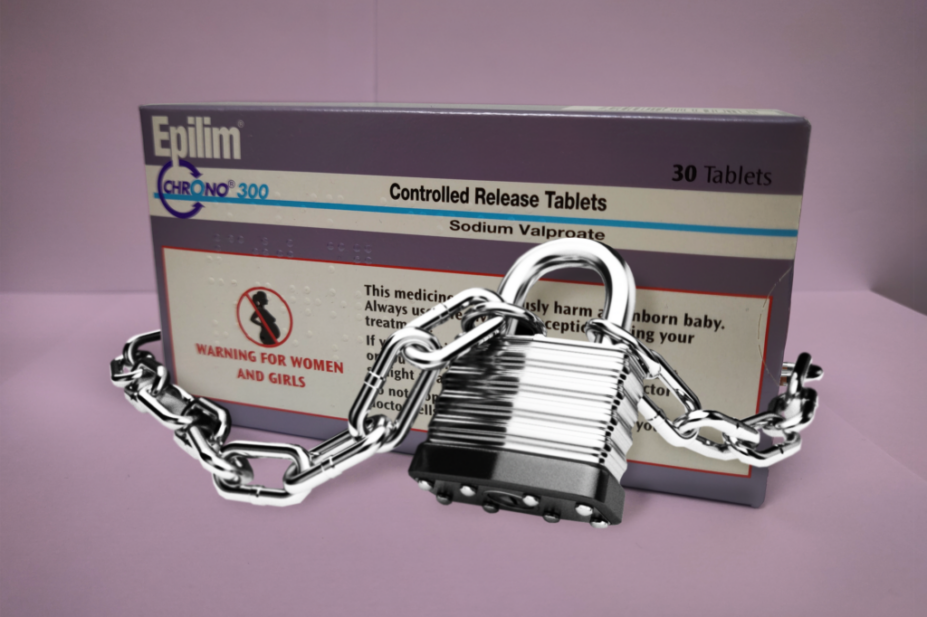
Shutterstock.com/The Pharmaceutical Journal
Sodium valproate is a highly effective anti-seizure medication, most commonly used in the treatment of epilepsy, bipolar disorder and, occasionally, migraine.
Since the medicine was licensed for use in 1973, we have come to understand more about the risks associated with its use during pregnancy.
The Medicine and Healthcare products Regulatory Agency (MHRA) states that if valproate is taken during pregnancy, there is an 11% chance of the child being born with a major malformation and a 40% chance of them having a developmental disorder[1].
The historic approach to valproate prescribing has been widely thought of as the pinnacle of medical paternalism, with many consultants failing to disclose known risk information associated with the medication.
Patient advocacy groups have been campaigning for more than a decade to improve awareness of the risks, tighten prescribing practices among women and girls of childbearing age, and seek institutional redress for the injustices faced by those denied the opportunity to make an informed decision about their medication options.
While initial changes to prescribing focused on improving the education of patients concerning the risks of taking valproate during pregnancy, namely the 2016 ‘valproate toolkit’, prevention of valproate-exposed pregnancies became the primary aim of additional regulation[2].
In 2018, the Pregnancy Prevention Programme (PPP) was introduced, which removed valproate as the first-line treatment for girls and women of childbearing age, and mandated the use of long-acting reversible contraception if a patient is to remain on the drug[1].
This regulation was strengthened again, in December 2022, by the Commission on Human Medicines (CHM), with the aim of preventing potential transgenerational harms associated with valproate. Now, no patient aged under 55 years is to be initiated on valproate unless two specialists independently confirm that alternatives are neither tolerated or effective[3].
On 23 March 2023, a coalition of 11 epilepsy charities wrote to Steve Barclay, secretary of state for health and care, to urgently review this latest decision, maintaining the new restriction on access to valproate as “unsafe and unworkable”[4].
The current policy approach is unduly restricting a potentially life-saving medication based on an individual’s capacity to reproduce
I believe that, in addition to the CHM update, the PPP — as currently formulated — must also be re-examined.
This is not an attempt to undermine the necessary work of patient advocacy groups, but the current policy approach is unduly restricting a potentially life-saving medicine based on an individual’s capacity to reproduce.
The prevention of foetal exposure has been elevated to the dominant priority, with its potential benefits as an effective medication taking second place. This raises questions relating to the limits of patient autonomy, individual attitudes towards risk and our responsibility to minimise ‘preventable’ harm and disability for future generations; all of which fall outside the current mainstream narrative around valproate.
Healthcare professionals (HCPs) with valproate prescribing responsibilities are faced with a complex balancing act of enforcing the restrictions around valproate and fulfilling their wider professional obligations concerning informed consent. This is particularly challenging for neurologists, who generally believe that valproate should remain the first-line treatment for idiopathic generalised epilepsies (IGEs), which affect around 25% of all people with epilepsy[5].
I carried out interviews with 20 consultants, who have prescribing responsibilities for valproate, with the aim of exploring the tensions between the use of the PPP and ensuring valid, legal consent[6]. My argument is informed by this empirical research and the associated wider literature to highlight the main areas of concern around the UK’s valproate problem[7].
Treating patients as permanently ‘pre-pregnant’
Since 2018, a body of literature has emerged about the pitfalls of the PPP[8–10]. One argument is that the PPP boils down to a sexist diktat, which enforces a “blanket ban on drug choice based on gender”[11]. It further assumes that all those with the capacity to reproduce are at a constant “risk of pregnancy” and that those pregnancies will always want to be continued. This criticism highlights how regulation seems to have swapped our temporal understanding of epilepsy and pregnancy: rather than promoting the most effective medication for IGEs, restrictions have been repeatedly strengthened to prevent foetal exposure[12,13].
Indeed, one HCP I interviewed argued that treating valproate as something that must be avoided at all costs implies an assumption that the priority for all women is the safety of their future foetus; that the risk of teratogenicity will be the overriding factor in their medical decisions.
Pregnancy and conceiving are not constant states. It makes more sense to control the epilepsy with the most effective medicine for as long as possible — if this is the patient’s goal — and then encourage switching when the patient wants to start a family. To conflate pregnancy capacity with pregnancy intention is to jeopardise the life and wellbeing of women in, potentially, their formative years, where education, employment and travel may be more of an immediate priority.
Transformation of informed consent
Within much of the public discourse around restricting the use of valproate, it is thought that an informed choice is only achievable through a formalised PPP.
This idea is fundamentally flawed, predicated on the idea that if people knew the risks, no one would choose a valproate-exposed pregnancy[9]. This diminishes the agency of individuals to make decisions. Patients must freely give permission for treatment decisions, supported by their HCP, and be given sufficient information about the risks and benefits[14,15].
In contrast, the PPP imposes a decision on patients and their HCPs. As one HCP I interviewed summarised: the right to make free, informed decisions, which are right for the patient, is “one of the tenets of consent”; it does not matter whether the HCP agrees.
The majority of discussion has centred on the risk to the potential foetus, but there are risks related to poorly controlled seizures, including sudden unexpected death from epilepsy
While complete disclosure of risk information is necessary for consent to be valid, this can be achieved without turning medical advice into mandated conditions that must be met before a prescription can be issued.
Further, the majority of discussion has centred on the risk to the potential foetus, but there are risks related to poorly controlled seizures, including sudden unexpected death from epilepsy (SUDEP).
Warnings should go beyond the usual messaging of “do not stop taking this medicine unless your doctor tells you to…”. The potential for increased seizures and SUDEP amounts to material information by legal standards; therefore, the communication of these risks should be weighted equally to the communication of teratogenic risks[9].
A discussion of “reasonable alternatives” is a further tenet of consent[14,15]. Removing valproate from the discussion altogether undermines the ability of patients to consent and leaves HCPs at risk of failing to meet this legal obligation. There is currently debate about this within the neurological community. One consultant said mentioning valproate to patients “doesn’t achieve anything” if it will not be offered as a treatment option, but this is hugely controversial. Does it not ensure that patients are both given reasonable choice and are truly informed when providing their consent to treatment, even if it does not end up being valproate?
‘Avoidable’ exposure
To refer to a valproate-exposed pregnancy as avoidable assumes there are other options that are just as effective. For some patients, we know that this is not the case. Research published in 2020 found that “33–43% of clinicians reported seizure control deterioration in women changed to alternatives to valproate”[16].
Unfortunately, these voices are often not heard in the development of valproate-related policy and regulation. Following the CHM recommendations, Faye Waddams, an advocate for women with epilepsy who has publicly shared her experiences with valproate, expressed her frustrations regarding knee-jerk reactions to valproate and the impact it may have on those who need it[17]. She explained that valproate had been the only drug that had ever given her stable seizure control[18].
The efforts to avoid valproate at all costs, regardless of pregnancy intention, forces some patients to risk inadequately controlled seizures for significant periods of time. It also forces HCPs to prescribe double or triple therapies. Some HCPs I spoke to raised the possibility of trying patients on high doses of antiseizure medication combined with benzodiazepines, with no risk information available, just to avoid valproate.
This is a truly concerning implication of the messaging ‘avoid valproate at all costs’. Any mention of dose-related effects is routinely minimised in public discussion, but prescribing high doses of alternative medications could pose similar risks to lower doses of valproate, yet be less effective at controlling seizures.
Regulation that impedes ethical practice
The PPP runs the risk of impeding ethical practice in several circumstances, including where an individual lacks the capacity to consent; for example, someone with an intellectual disability. This issue has been raised in several articles which speak to the “exceptional circumstances” whereby the PPP should not apply[8–10].
Imposing contraception on people who may not otherwise choose it certainly raises ethical questions
Despite my research focusing on capacious decision making, all interview participants brought up the requirement of enforcing PPPs in patient populations who lack capacity — efforts are underway to address this troubling situation. But imposing contraception on people who may not otherwise choose it certainly raises ethical questions, including the limits of patient autonomy in the right to refusal, how much risk individuals should be permitted to take on with regards to pregnancy and what it means for society if we tell certain patient populations that they should not be allowed to conceive on medication that enables them to live a seizure-free life.
As one consultant articulated, while “avoidable” teratogenic harm is a tragedy and extremely distressing: “I think we have to also remember there are some unavoidable teratogenic harms, and some of them are associated with a woman’s right to choose.”
Robust action needed
In moving the conversation forward, the majority of neurologists I spoke to have called for more robust action from the MHRA.
As some of the consultants said in their interviews, where are the other valproate registers; for example, for patients who are not on valproate, but perhaps should be; for A&E/hospital admissions among this cohort of patients; or for seizure-related injuries or SUDEPs among patients who would have otherwise chosen valproate?
If we are to reach any type of definitive decision as to how best to regulate valproate, we need a full audit of the current approach.
One consultant told me they had heard a colleague refer to a valproate-exposed pregnancy as a “never event”. This categorisation is indicative of the complete chill effect the PPP has had — it does not take into account the damage it may have on some patients and their life choices. To reduce the problem down to “women keep conceiving on valproate” is to do wrong by many women’s experiences, their reliance on life-saving medication, and the difficult decisions they have to make. This is further underscored by society’s demand for complete risk elimination, which is neither achievable in most treatment options or in pregnancy more broadly.
As one HCP suggested, the goal shouldn’t be “no pregnancies on valproate” but rather “no uninformed pregnancies on valproate”.
- 1Valproate: reminder of current Pregnancy Prevention Programme requirements; information on new safety measures to be introduced in the coming months. GOV.UK. 2022.https://www.gov.uk/drug-safety-update/valproate-reminder-of-current-pregnancy-prevention-programme-requirements-information-on-new-safety-measures-to-be-introduced-in-the-coming-months (accessed 27 Apr 2023).
- 2New toolkit supports better understanding of the risks of valproate and pregnancy. GOV.UK. 2016.https://www.gov.uk/government/news/new-toolkit-supports-better-understanding-of-the-risks-of-valproate-and-pregnancy (accessed 7 Apr 2023).
- 3Update on MHRA review into safe use of valproate. GOV.UK. 2022.https://www.gov.uk/government/news/update-on-mhra-review-into-safe-use-of-valproate (accessed 27 Apr 2023).
- 4PUBLIC STATEMENT FROM COALITION OF EPILEPSY ORGANISATIONS. SUDEP Action . 2023.https://sudep.org/article/public-statement-coalition-epilepsy-organisations (accessed 27 Apr 2023).
- 5The Independent Medicines and Medical Devices Safety Review. IMMDS Review. 2018.https://www.immdsreview.org.uk/downloads/Evidence/FOR%20PUBLICATION%20-%20Professional%20and%20Trade%20Bodies.pdf (accessed 27 Apr 2023).
- 6Arkell R. Communicating the Risk of Taking Medicines to (Potentially) Pregnant Women post-Montgomery: A Socio-Legal Exploration. UK Research and Innovation. https://gtr.ukri.org/projects?ref=studentship-2290111 (accessed 27 Apr 2023).
- 7Why is the UK struggling to contain its sodium valproate problem? Pharmaceutical Journal. 2023. doi:10.1211/pj.2023.1.174630
- 8Watkins LV, Cock HR, Angus-Leppan H, et al. Valproate and the Pregnancy Prevention Programme: exceptional circumstances. Br J Gen Pract. 2019;69:166–7. doi:10.3399/bjgp19x701897
- 9Angus-Leppan H, Liu RSN. Weighing the risks of valproate in women who could become pregnant. BMJ. 2018;:k1596. doi:10.1136/bmj.k1596
- 10Watkins L, Cock H, Angus-Leppan H, et al. Valproate MHRA Guidance: Limitations and Opportunities. Front. Neurol. 2019;10. doi:10.3389/fneur.2019.00139
- 11Lawthom C. Valproate and epilepsy: for women as well as men. Pract Neurol. 2018;18:222–3. doi:10.1136/practneurol-2018-001931
- 12Marson AG, Al-Kharusi AM, Alwaidh M, et al. The SANAD study of effectiveness of valproate, lamotrigine, or topiramate for generalised and unclassifiable epilepsy: an unblinded randomised controlled trial. The Lancet. 2007;369:1016–26. doi:10.1016/s0140-6736(07)60461-9
- 13Marson A, Burnside G, Appleton R, et al. The SANAD II study of the effectiveness and cost-effectiveness of valproate versus levetiracetam for newly diagnosed generalised and unclassifiable epilepsy: an open-label, non-inferiority, multicentre, phase 4, randomised controlled trial. Lancet 2021;397:1375–86. doi:10.1016/S0140-6736(21)00246-4
- 14Decision making and consent. General Medical Council. https://www.gmc-uk.org/ethical-guidance/ethical-guidance-for-doctors/decision-making-and-consent (accessed 27 Apr 2023).
- 15Montgomery (Appellant) v Lanarkshire Health Board (Respondent) (Scotland). The Supreme Court. 2015.https://www.supremecourt.uk/cases/uksc-2013-0136.html (accessed 27 Apr 2023).
- 16Angus‐Leppan H, Moghim MM, Cock H, et al. Valproate risk form—Surveying 215 clinicians involving 4775 encounters. Acta Neurol Scand. 2020;141:483–90. doi:10.1111/ane.13231
- 17Faye Waddams, advocate for women with epilepsy, responds to recent Sunday Times valproate article. Epilepsy Research UK. 2022.https://epilepsyresearch.org.uk/epilepsy-advocate-faye-sunday-times-valproate-article/ (accessed 27 Apr 2023).
- 18Waddams F. BLOG 93: VALPROATE – DON’T WE DESERVE BETTER? Epilepsy, Pregnancy, Motherhood & Me. 2022.https://fairyfaye1986.weebly.com/blog/blog-93-valproate-dont-we-deserve-better (accessed 27 Apr 2023).
3 comments
You must be logged in to post a comment.
You may also be interested in

‘No evidence’ that paracetamol use during pregnancy causes autism, ADHD or intellectual disabilities, meta-analysis finds

Levetiracetam information updated to include studies that suggest no link to autism

As someone who does not specialise in neurology and has only heard the mainline narrative, this was a fantastic read. True food for thought, with excellent points well argued and which need wider and (ironically) more informed debate. Well done to the author.
An excellent, thoughtful and analytical article that crystallises so many of the concerns I have felt as I've seen this approach unfold. Thank you for writing and publishing it Rachel.
nice blog, useful information is shared on this website. Thanks for sharing.